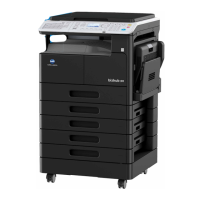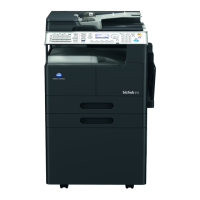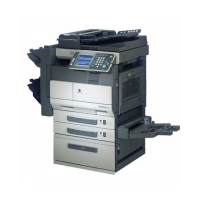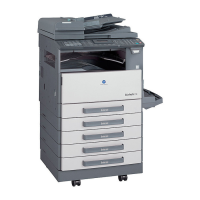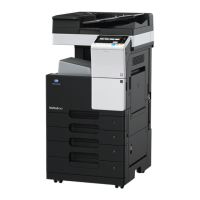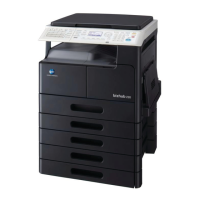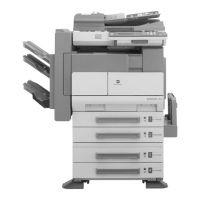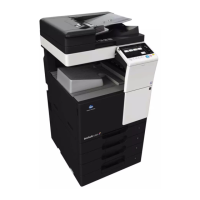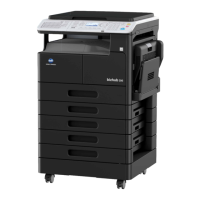
Do you have a question about the Konica Minolta bizhub 266 and is the answer not in the manual?
| Functions | Print, Copy, Scan, Fax |
|---|---|
| Print Speed (Black & White) | 26 ppm |
| Print Resolution | 600 x 600 dpi |
| Monthly Duty Cycle | 50, 000 pages |
| Standard Paper Capacity | 250 sheets |
| Automatic Document Feeder | Up to 50 sheets |
| Copy Speed (Black & White) | 26 cpm |
| Copy Resolution | 600 x 600 dpi |
| Scan Resolution | 600 x 600 dpi |
| Fax Transmission Speed | 33.6 kbps |
| Maximum Paper Size | A3 |
| Duplex Printing | Yes |
| Type | All in One Printer |
| Connectivity | USB, Ethernet |
| Scanner Type | Flatbed and ADF |
| Network Connectivity | Yes |
| Operating System Compatibility | Windows, Linux |
Provides a greeting and overview of the user's guide.
Explains notations, symbols, and procedural instructions used in the manual.
Details how original and paper sizes are indicated and represented.
Details the components and functions of the machine's control panel.
Explains the various messages displayed on the machine's screen.
Describes the default mode the machine operates in after startup or reset.
Covers the types of originals and how to use the ADF and glass.
Lists types of originals that should not be loaded into the ADF.
Guides through essential initial settings and checks before operation.
Details how to set the machine's current date and time.
Explains how to configure daylight saving time settings.
Provides steps to register the machine's own fax number.
Guides on how to register the sender's name for fax headers.
Details how to set the telephone line type (Tone/Pulse).
Explains how to adjust the line monitor sound volume.
Guides on selecting the communication line type (PSTN/PBX).
Outlines the step-by-step process for sending a fax.
Explains methods for loading originals into the ADF or onto the glass.
Details how to adjust image quality settings for fax transmission.
Covers various methods for specifying fax destinations.
Explains how to use one-touch dial keys for sending faxes.
Guides on using speed dial numbers for fax transmission.
Details how to send faxes to registered groups.
Explains how to use programmed dial settings for faxing.
Covers searching and selecting destinations from the address book.
Explains how to combine dial functions for fax transmission.
Details how to send a fax to multiple destinations in one operation.
Explains how to redial the last fax destination.
Describes actions to take when memory becomes insufficient during scanning.
Provides guidance on troubleshooting transmission failures.
Explains how to send a fax after a voice conversation.
Details how to cancel ongoing or reserved fax transmissions.
Guides on viewing and printing transmission and reception results.
Describes the different types of reports and lists available.
Explains the differences and usage of memory and immediate transmission.
Details how to schedule fax transmissions for a specific time.
Explains how to send multiple scanned originals at a set time.
Covers memory receiving, paper sizes, and paper priority for received documents.
Explains how to manually receive faxes after speaking with the sender.
Details how to use the machine as a phone to make calls.
Explains how to receive calls when the machine is used as a phone.
Details F-code transmission features for secure communication.
Guides on setting F-codes (SUB, SID) during direct fax number entry.
Explains how to register F-codes when saving destinations.
Covers confidential fax transmission using user boxes for secure transfer.
Provides steps to register a confidential user box in advance.
Details how to send important documents securely to a user box.
Explains how to print documents received via confidential reception.
Covers sending documents based on the receiver's polling request.
Guides on utilizing the polling TX function for sending saved originals.
Explains how to delete polling TX documents from memory.
Details how to receive documents initiated by the machine's polling request.
Explains how to send documents to a relay station for broadcasting.
Guides on configuring the machine to act as a relay station.
Explains how to forward received faxes to another destination.
Covers initial settings required for Internet fax transmission.
Lists the essential items to configure for Internet Fax functionality.
Outlines the fundamental steps for sending an Internet fax.
Explains how to search for email addresses using the address book.
Details settings for transmission time, size, resolution, and coding.
Guides on setting a specific time for Internet fax transmission.
Explains the choice between basic and advanced transmission modes.
Details how to set the maximum transmission size for Internet faxes.
Explains how to set the maximum resolution for transmitted images.
Guides on selecting the compression method for data transmission.
Covers settings for image quality and density during scanning.
Details how to select the image quality for scanning.
Explains how to adjust the density level for scanned images.
Covers additional functions like specifying titles and forward destinations.
Guides on assigning a title to an email.
Details how to specify a destination for receiving result reports.
Explains how to enable or disable header printing for emails.
Covers initial settings and data types for receiving Internet faxes.
Lists items to configure for successful Internet fax reception.
Details the types of data that can be received via Internet fax.
Explains how to set up automatic reception of Internet faxes.
Guides on manually receiving Internet faxes.
Provides a general introduction to the PC-FAX function.
Defines PC-FAX and its usage without local printing.
Specifies the system requirements for using the PC-FAX driver.
Guides on connecting the machine and installing the PC-FAX driver.
Details the procedures for installing the fax driver.
Explains how to connect and install the fax driver via USB or network.
Guides on automatic installation of the fax driver via the installer.
Provides instructions on how to remove the fax driver.
Details the process of sending a fax using the PC-FAX driver.
Covers creating data, selecting the printer, and specifying destinations.
Explains how to create and attach a cover sheet to faxes.
Guides on configuring various settings within the fax driver.
Details basic configurations like page layout, paper size, and orientation.
Explains how to set sender details such as name and contact information.
Guides on adding new destinations to the PC-FAX address book.
Explains how to modify existing entries in the address book.
Details how to create and manage groups of destinations.
Explains how to edit existing destination groups.
Guides on removing destinations or groups from the address book.
Explains how to import address data from CSV files.
Details how to save address book data in CSV format.
Provides access to various machine settings and configurations.
Covers registration and management of fax destinations.
Lists the types of destinations that can be registered (one-touch, speed, group, program).
Guides on registering destinations using one-touch dial keys.
Explains how to modify or remove one-touch dial entries.
Details how to register destinations using speed dial numbers.
Explains how to modify or remove speed dial entries.
Guides on registering multiple destinations as a group.
Explains how to modify or remove group dial entries.
Details registering destinations with specific functions (e.g., timed transmission).
Explains how to manage sequential broadcast transmission programs.
Guides on managing specified-time transmission programs.
Explains how to manage confidential transmission programs.
Details how to manage polling RX programs.
Explains how to manage relay instruction transmission programs.
Covers registration items for efficient fax function usage.
Lists registration items for fax functions like Mailbox and Relay Box.
Guides on registering confidential user boxes for secure reception.
Explains how to delete confidential user box settings.
Details registering relay user boxes for relay transmission.
Explains how to delete relay user box settings.
Covers various transmission settings for fax communication.
Lists configurable transmission settings like density and quality.
Guides on setting the scanning density for fax originals.
Explains how to prioritize image quality settings.
Details how to set the default transmission mode (Memory TX/ADF TX).
Explains how to enable or disable header printing for faxes.
Details how to enable fax number confirmation for direct input.
Covers various receiving settings for fax communication.
Lists configurable receiving settings like memory RX and forward mode.
Guides on setting the memory RX mode, including time and password.
Explains how to manually release the memory RX mode.
Details how to set the number of rings for auto reception.
Explains how to configure print reduction settings (split, cut).
Guides on setting when received faxes should be printed.
Explains how to select between Auto RX and Manual RX modes.
Details how to set up forwarding of received faxes.
Explains how to enable or disable printing of footer information.
Guides on selecting the paper tray for printing.
Explains how to restrict reception to registered fax numbers.
Covers settings for automatic printing of various fax reports.
Lists report types and their automatic printing configurations.
Guides on enabling automatic printing of activity reports.
Explains how to enable automatic printing of reservation reports.
Details enabling automatic printing of transmission result reports.
Explains how to enable automatic printing of receiving result reports.
Introduces Web Connection as a remote control utility.
Specifies the operating systems and browsers compatible with Web Connection.
Covers accessing and navigating the Web Connection interface.
Details the steps to access Web Connection via a web browser.
Explains the layout and elements of the Web Connection interface.
Differentiates between user and administrator access modes.
Guides on operating Web Connection by selecting tabs and menu items.
Describes the functions available to general users in Web Connection.
Displays the machine's system configuration and status.
Provides detailed information on trays, ROM version, and interfaces.
Enables checking of machine count information like total counts.
Covers settings related to the machine's power save mode transition.
Provides access to online help and support information.
Details how to check and manage print jobs.
Explains how to download PRN files for printing on the machine.
Covers settings related to printer output, such as copies and paper source.
Details settings for output paper size and layout.
Explains settings relevant to the printer's PCL function.
Guides on printing test pages like Configuration Page and PCL Font List.
Details how to check the PCL font list.
Explains how to check registered one-touch dial settings.
Details how to check registered speed dial settings.
Explains how to check registered group dial settings.
Covers basic network settings information.
Lists common messages and their corresponding corrective actions.
Troubleshoots common issues encountered when sending faxes.
Troubleshoots common issues encountered when receiving faxes.
Troubleshoots issues related to making calls with the machine.
Provides technical specifications for the fax function.
Covers the Local Setup Utility (LSU) for machine configuration.
Defines LSU and its supported functions.
Specifies the system requirements for installing LSU.
Guides on connecting the machine and installing LSU.
Details the steps for installing the LSU software.
Explains how to launch the LSU application.
Describes the interface and buttons of the LSU application.
Guides on establishing a connection between LSU and the machine.
Explains how to download configuration data from the machine.
Details how to create a new configuration file in LSU.
Guides on registering destinations in LSU's one-touch dial.
Explains how to edit one-touch dial entries via LSU.
Details registering destinations in LSU's speed dial.
Explains how to edit speed dial entries via LSU.
Guides on registering destinations into groups using LSU.
Explains how to edit destinations within a group via LSU.
Guides on printing lists of registered dial destinations.
Explains how to save machine settings to a computer via LSU.
Details how to save machine settings onto the machine itself using LSU.
Explains how to save utility settings using LSU.
Guides on configuring administrator settings via LSU.
Explains how to view the machine's total counters using LSU.
Guides on viewing the machine's configuration page via LSU.
Details the procedure for uninstalling the LSU software.
